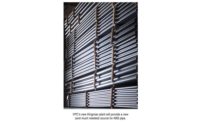It is often said that adversity builds character. But in some cases, it also helps build a better piping system.
During a recent cold and snowy snap, a combination of a heavy snowpack and high winds caused a portion of the roof to collapse at the head-quarters of IVP Plastics in Washington, Illinois. Fortunately, no one was injured (the collapse took place on a Saturday), and the damage was somewhat mitigated by the presence of a crane rail running the length of the ceiling.
In the bigger picture, this bit of adversity wrought by Mother Nature served to introduce IVP Plastics to Aquatherm polypropylene pipe — and who better than a plastics manufacturing company to benefit from the advantages offered by this type of piping?
Fateful day leads to new conversations
IVP Plastics was founded in 1953, and today is a leading provider of customized plastic parts for the agricultural, heavy equipment and automotive industries. The company’s services include consultation, design, prototyping and material management, and its manufacturing capabilities include thermoplastic molding, injection molding, insert molding, in-mold labeling and sonic welding. The company’s mission is to provide outstanding customer service based on three core values: innovation, value and performance.
Fate reared its head at IVP Plastics on that March afternoon. Central Illinois’ winter weather can be notoriously brutal, and a late-season storm took its toll on the 20,000-square-foot clear-span building. Although damage to the building was significant, the crane rail spared much of the manufacturing equipment from serious damage.
About two weeks after the collapse, while a general contractor was still shoring up the building, Jeff Frieden, president of Warner Mechanical out of Edwards, Illinois, had an opportunity to visit the damaged manufacturing facility.
“We sat down with the IVP Plastics team, the general contractor and the insurance company, and the bottom line was that time was of the essence,” Frieden says. “Another contractor had put together a temporary chiller system to keep them in production, but the long-term solution was to take the building down.”
Once the decision was made to replace the damaged building with a new one, IVP Plastics requested that Warner Mechanical design the process piping system for the 16 machines that would be moving into the new building. The old process cooling system had used 6-inch PVC pipe running overhead at the ceiling, and the company said it preferred a system that would place the pipe in mechanical trenches behind each run of machines.
Frieden immediately knew Aquatherm would be a good choice for such a piping application, and IVP Plastics’ management agreed — not surprising for a company with a mission statement built on innovation, value and performance.
Frieden turned to Warner Mechanical’s partner, Columbia Pipe and Supply out of Peoria, Illinois. Columbia supplied 1,575 feet of 4-inch, 247 feet of 3-inch, and 156 feet of 1 1/2-inch Aquatherm SDR-11 MF Blue Pipe for the process chiller piping, as well as 507 feet of 1-inch Aquatherm Green Pipe for clean-up water.
Columbia also supplied the necessary fittings, flanges, fusion outlets and transitions. Warner Mechanical owns the McElroy 1/2-inch to 4-inch fusion irons used on this project, but Columbia provides butt-fusion tools for projects that require larger sizes.
“Columbia Pipe is very supportive of having all the tooling we need for projects,” Frieden notes. “We’ve never had to wait on tools.”
Leak-free performance
The system designed by Warner Mechanical, with support from Keith Engineering Design out of Peoria, calls for most of the pipe to be located in trenches under the equipment in the concrete floor of IVP Plastics’ new manufacturing facility. Fittings emerging from the trench covers allow the manufacturing machines to be easily hooked up whenever the process line is reconfigured. The company’s Budzar chiller provides 40° F cooling water to the machines with return water flowing through the Aquatherm pipe at up to 100°.
“We decided to do things differently at the new facility,” explains Joe Camp, engineering manager at IVP Plastics. “We wanted to put the process plumbing in the floor, and it was Jeff’s recommendation to use the Aquatherm pipe for that. It will be nice to not have pipes sweating and dripping, which was a problem when we had the PVC overhead. Another nice feature of the Aquatherm pipe was that we could get longer continuous lengths of pipe, so we had fewer joints to deal with.”
The clincher for IVP Plastics, according to Camp, was Aquatherm’s virtually leak-fee performance that — because it was installed by Aquatherm-trained technicians — is backed by an extensive and comprehensive 10-year warranty.
“There is definitely peace of mind that comes from investing in a product with a warranty like that,” Camp states.
Colorful pipe draws attention
For Warner Mechanical, an undeniably interesting aspect of this project was installing Aquatherm pipe in a plastics manufacturing facility.
“As we discussed this project with IVP Plastics, the owners were very pleased to see the range of temperatures and pressure ratings that were available to them,” Frieden says. “After our initial conversations, the owners researched it and were very impressed by what they saw. When you’re working with a plastics company and they’re researching plastics, you’re playing with experts.”
Once the project began, the installation of the Aquatherm pipe attracted a great deal of attention from the IVP Plastics personnel.
“The engineers were watching us put this in, and it really intrigued them — being a plastics company — that we were putting this thermoplastic piping in their building,” Frieden says. “The engineers liked the heat fusion process, and they all came out of their offices and took a peek. Some were familiar with solvent-weld types of plastic, but once they saw the benefits of the heat-fusion welding process, they had total confidence in the durability of the product. They can understand when it’s properly heat-fused there will be no leakage problems.”
Camp agrees and notes one other benefit of the new piping system: it just flat-out looks good.
“Most of it is buried, but there are sections where it runs up a wall or transitions from one trench to another, and it’s got that nice pop of blue,” he states. “When we bring a guest or customer through, they’re pretty impressed with it.”
Frieden adds that Aquatherm was much easier to heat-fuse and place in the trenches than metal pipe would have been.
“I think any time you’re in a process where you would typically turn to welded piping, you should look at the time savings and durability of Aquatherm pipe,” he says. “For this customer, using Aquatherm enabled us to reduce the time it took to complete the system and allow the owner to start production.
“I also think it’s a great choice any time you’re in a buried or constrained space. It’s easier to work with than metal pipe, and it offers a big advantage in peace of mind. You know you can walk away from it when the job’s complete and not worry about leaks.”






